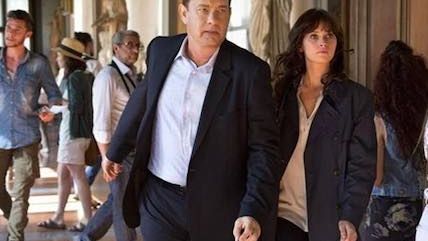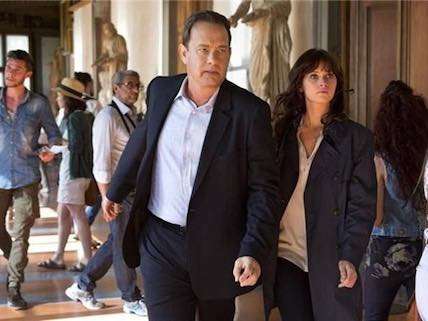Movie Reviews: Inferno and Gimme Danger
Tom Hanks returns to Dan Brown land, and Iggy and the Stooges rage again.


Ron Howard's Inferno can be recommended for the opportunity it offers to avoid reading the Dan Brown novel on which it's based. Brown's bestseller, another exercise in his trademark verbal incontinence and wooden characterizations, would seem to defy cinematic adaptation and, as we see here, actually does. Director Howard, in his third go-round with Brown's tepid hero, the "Harvard symbologist" Robert Langdon, has attempted to rein in the author's wandering plot and gushers of babble; but trimming and compressing them has only added to the story's incoherence.
Langdon (Tom Hanks again) is back in Italy, this time waking up in a Florence hospital with a head wound and no idea where he is—the last thing he remembers is being at home in Cambridge a few days earlier. Attending physician and requisite brainy babe Sienna Brooks (Felicity Jones) sympathizes, but before she can be much help an assassin called Vayentha (Ana Ularu) storms in and starts shooting up the ER. Langdon and Sienna flee, an activity which will consume most of their time for the rest of the movie.
Holed up in Sienna's apartment, Langdon discovers something odd in his pocket—a "bio-tube" that projects an image of Botticelli's "Map of Hell," originally an illustration for Dante's "Divine Comedy." Aha! "The circles of Hell have been rearranged," Langdon observes. He and Sienna now make their way to the Palazzo Vecchio, where Dante's death mask is on display, along with a tangentially related painting by Vasari.
Hot on their trail all of a sudden are agents of a mysterious international security outfit called the Consortium, led by the droll Harry Sims (Irrfan Khan, having a lot of fun), and heavily armed representatives of the World Health Organization (who knew that WHO had a SWAT team?), led by Langdon's old flame Elizabeth Sinskey (Sidse Babett Knudsen). For good measure, there's also a surveillance drone flitting about. Much fleeing through the Boboli Gardens ensues, and then there's further fleeing to Venice to find a "chthonic monster" (only metaphorical, unfortunately). Once arrived in the Serene Republic, we're told more than we'll ever need to know about the "Horses of Constantinople," a tip-off to our next destination, a "sunken palace" in Istanbul.
We've already been informed that the cause of all this hubbub is an American billionaire and TED celebrity named Bertrand Zobrist (Ben Foster), whose belief in an impending over-population catastrophe has compelled him to create a super-virus called Inferno, which will wipe out 95 per cent of humanity in order to allow the remaining five per cent (including Zobrist, no doubt) to survive and prosper. It won't be so bad, Zobrist says: after all, "The Black Plague gave us the Renaissance." Zobrist's neo-Malthusian theory has been widely debunked ever since the late-'60s heyday of Paul Ehrlich, who propounded it in his nitwit bestseller The Population Bomb. But it still finds favor, apparently, among marginally competent thriller-writers.
Despite an effective plot switch and at least one memorable image (a symphony orchestra set up in a vast cavern of red water), the movie is both too fast and too slow. Its indiscriminate frenzy is draining, but then so is its overload of digression: there's much talk of Transhumanism, and eye-glazing references to a map of Armenia and a "treacherous doge of Venice." Hanks, one of the most personable of Hollywood stars, is given little outlet for his skills in playing the befuddled Langdon. And Jones, so appealing in films like The Theory of Everything and Like Crazy, is hobbled by an enforced lack of chemistry between her character and the man with whom she's keeping so much company.
The Langdon films are big moneymakers (especially The Da Vinci Code, although Angels & Demons less so). But at this point, it'd be nice if Hanks and Howard could find the wherewithal to bail out of the franchise—what else can be done with it? Unfortunately, the Dan Brown series continues to beckon—there's one book left to go.

Gimme Danger
Clearly a labor of punk-rock love, Jim Jarmusch's Gimme Danger tells the story of Iggy Pop and the Stooges in all of its calamity and eventual triumph. Longtime fans of the band won't find a lot that's new in this documentary. We hear Iggy dodging bottles on a Detroit stage. We see him walking out into a concert crowd on a sea of upraised hands, slathering peanut butter on his chest. We're regaled once again with the story about how the blitzed-out Stooges once attempted to drive a 12-foot-tall truck under a bridge with a 10-foot clearance. It's still good stuff, and it bears repeating.
What juices the story anew is the first-hand testimony Jarmusch has gathered from former Stooges—the late Ron and Scott Ashton, and the great guitarist James Williamson—and from rock-biz tastemaker Danny Fields, the man who got the band signed to Elektra Records, where they made two great, pretty much unsellable albums before flaming out. We get the heroin days, the Bowie connection, the catastrophic recording of Raw Power (whose idea was it to let Iggy do the mix?), and the long-delayed induction into the Rock and Roll Hall of Fame (Iggy gives everybody the finger). And through it all we have the unstoppable Pop himself offering sardonic commentary. ("We were sinking fast into semi-obliviousness.")
Best of all, naturally, is the music—wall-to-wall hits! Tracks like "TV Eye," "I Wanna Be Your Dog," and "Loose" have never sounded better. (Jarmusch, a musician himself, has done a stellar job with the soundtrack.) The Stooges may have receded into history, but their shake appeal endures.


Show Comments (93)